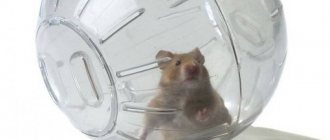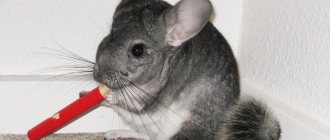- home
- Acquisition
12.04.2018
Hamsters are beautiful and interesting animals. They are considered the most unpretentious of all pets. To decide whether to get a rodent, think carefully. After all, a hamster in the house is not just a toy, but a big responsibility.
Is it worth getting a hamster for a child?
Such a pet will be interesting for an owner of any age.
Very often, adults buy hamsters for their children. At the same time, you need to be prepared for the fact that all the worries about maintaining the animal may fall on the shoulders of the parents. Children over 7-8 years old can already help an adult care for a rodent. Parents of preschool children should not trust the procedures for cleaning the cage and feeding the hamster to their children. Small children may eat the trash or get hurt. Therefore, it is better to invite the child to observe the actions of an adult or perform simple tasks under the strict supervision of a parent. Usually a tamed hamster that is not afraid is very friendly. If the baby squeezes the animal tightly in his hand and scares it with laughter or screaming, the rodent may bite him. In this case, the wound should be treated.
Experts do not recommend getting a hamster for a very young child, since he is not able to care for the animal, during games he can unintentionally harm the pet, and a frightened animal will bite the baby. The advantage of keeping such a pet is that it teaches both preschoolers and teenagers responsibility and discipline.
Before buying a rodent, you need to be prepared for the fact that the animal has a short life span, so you need to choose the right words so that the child does not become depressed after losing his pet. Most often, 2–5 days are enough for children to overcome such stress.
Treatment
You can relax here. You won't have to vaccinate your hamster; you'll save your hard-earned money on vaccinations and veterinarian fees. Firstly, these rodents rarely get rabies. Secondly, vaccinating an animal that lives only two or three years is simply not profitable and pointless. Virus-resistant antibodies simply do not have time to be developed in the hamster’s body during its short life.
But you cannot do without treatment completely. The rodent may develop parasites - worms and fleas. To make your animal feel comfortable, you will have to buy a special powder and treat it. This powder costs about 100 rubles, and it won’t last a hamster’s entire life.
Of course, rodents sometimes get more seriously ill. But in each specific case, you need to consult a veterinarian, who will prescribe the appropriate treatment, the cost of which can be found out directly at the veterinary clinic.
Why does a hamster stuff its cheeks?
If in its natural environment a hamster requires large supplies of food, then there is no need for a pet to do this. But he still periodically continues to hide food in his cheeks. This occurs due to the preservation of genetic information transmitted from generation to generation, even in individuals breeding in captivity. The only difference is that your pet rodent doesn't have to do this regularly. Due to changes in living conditions, the muscles of the cheek pouches atrophy over time, so indoor hamsters often suffer from an inflammatory process in the oral cavity.
Some pet hamsters do not use cheek pouches. Both young and adult individuals can do this. If the owner feeds his pet plenty and always has something to eat in his cage, then he has no need to stock up. But when an animal experiences moments of hunger, its reflex is triggered. Then he will hide a certain amount of the offered products “for a rainy day” in a secluded corner of the cage.
To take or not to take
Before you buy yourself a hamster, for example, a Djungarian, you need to think in advance and weigh everything that may be associated with this animal. First of all, remember that the hamster is a very territorial animal, which means it should be kept alone. Two individuals most likely will not get along in the same cage and such proximity will not lead to anything good.
If you live in an apartment and are wondering whether it’s worth getting a hamster, let’s analyze together all the pros and cons of keeping this animal.
Cons of decorative rats
Before you bring a little rat into your home, think about whether you are ready to accept him with all his shortcomings. The amount of responsibility does not depend on the size of the pet
Pay attention to the disadvantages of decorative rats
Short life expectancy
On average, rats live 2-2.5 years. With good care and heredity - 3-3.5 years, no longer. Parting with a smart and affectionate pet is unbearably difficult. This is the main disadvantage of rats - they live only a little longer than hamsters. But the owner usually does not develop a deep emotional attachment. Other rodents and lagomorphs - rabbits, guinea pigs, chinchillas and degus - live much longer than rats.
Rat "Siamese" color
Urine marks, feces
Although rats themselves are clean animals, they cannot be toilet trained like a cat or hamster. Peeing everywhere is necessary for them, this is how they mark their territory. I'm not sure about feces, but they poop wherever they want. Accordingly, after a walk you need to remove the “gifts”. When a rat crawls over a person, it can mark him too (pee).
Destroy things and repair
Call Captain Obvious, rodents are gnawing! Rats have incredibly strong and sharp teeth, allowing them to crush even concrete. Keeping smart animals in a cage all the time is cruel; they have to be let out to run around. And some damage is inevitable. Before a walk, you need to hide all things dear to your heart - documents, headphones. Rats chew curtains, wallpaper, books. My rat secretly chewed a round hole in the wooden bottom of the sofa, and made a luxurious nest in the quilted blanket that lay inside. I discovered this only in winter, but I was still surprised - where is he hiding for so long?
You need to decide in advance what you love more: rats or furniture
Poor health
Stories about the incredible vitality of rats cause them a lot of harm. People think that rats are “unkillable”, which means they can be fed everything, parachuted from a bunk bed, or allowed to swim in the bathtub. Firstly, you cannot compare the health of a wild pasyuk and a decorative rat. Secondly, the vitality of rats is primarily the well-being of the entire species, and not the individual. They have gained a formidable reputation for their extremely rapid reproduction. And fertility does not mean good health, rather the opposite. Rats catch colds easily, may suffer from digestive disorders, and get injured while walking. But the main thing is that they are susceptible to cancer. Their tumors grow rapidly and require immediate surgical intervention. The situation is complicated by the fact that only a small number of veterinarians are able and willing to treat rats. There is not a special doctor - a rodentologist - in every city. It is better to find out his contacts in advance from rat breeders or on rat breeding forums.
Read about how to properly feed a rat HERE (link will open in a new tab)
Curly mustache of a rex rat with wavy fur
May be noisy at night
In nature, rats are active at dusk and at night. Domestic rats often adjust their routine to suit humans, but still tend to be active at night. They can chew the metal bars of the cage and household items in it, and dig into the bedding. Consider this point - if the slightest noise prevents you from falling asleep, there is no place for a cage with rats in the bedroom. But children are usually not bothered by this night fuss, and they sleep peacefully next to their favorite pets.
The smell from the animal and from the cage
Many people even consider the smell from a clean and healthy rat to be pleasant. But in order not to smell the unpleasant smell from the cage, you will have to work hard. It is necessary to choose a good filler and change it regularly. Wash and clean the cage. Remove leftover food. The more rats, the more often cleaning is required. In addition, rats can piggy - scatter food and litter around the cage.
For most rat breeders, the animals walk freely around the room, returning to the cage at will. The larger the cell, the less likely it is that an unpleasant odor will occur.
Negative attitude of others
You should be prepared for the fact that some of your friends will stop visiting your home because you keep rats. Some people cannot stand their appearance, experiencing a feeling of disgust or fear. A phobia can be causeless and innate, like the fear of spiders. Or it may be associated with a traumatic experience of communicating with wild rats. My grandmother had one, and although she admitted that my pet had a cute face, she could not see his tail without shuddering. You can't force other people to like rats. Most likely, you will encounter cruelty and misunderstanding during the illness or death of a pet (“it’s just a rat”). You will also listen to lectures on the plague and other horrors associated with rats.
Plague on your home! Rat tails can be terrifying
Where is the best place to place a hamster's cage?
Where is the best place to place a hamster's cage?
The first question to answer is whether there are other pets in the house. If so, then hamsters should be safely isolated from them. In general, the rules for cell placement break down into three large components: air; sound and light; human activity. Let's go in order.
What to expect from hamsters in the first days of being at home. You will probably be surprised, but hamsters are very gentle and capricious creatures. The period of their initial adaptation to new conditions will take about two weeks. During this time, they will master new smells, get to know new people, and get used to their surroundings. It is better to determine the future location for the cage before purchasing. It is very bad when you constantly move the cage from place to place - your pets will become restless and anxious. Do not be intrusive and persistent towards animals in the first days; leave joint games and entertainment for later.
Place the cage correctly. Hamsters are very sensitive to drafts and temperature changes. Completely exclude places near fireplaces and stoves. Bathrooms and toilet rooms are not suitable, as there are a lot of hygiene products there. At the same time, the air in the room where the cage is located should be as clean and fresh as possible, and its circulation should be ensured (but not through a draft!).
As for sounds and light. Hamsters are nocturnal, so the sound of a running wheel spinning at night can be quite annoying.
If you are a light sleeper, take this into account. There should not be too much light falling on the cage, especially in the first weeks.
At first, hamsters will be extremely sensitive to every rustle; they will perceive the people around them as hostile, so they also do not need an abundance of light and extraneous sounds. Hamsters in the wild forage for food at night, so by placing their cage in the least lit area, we help them adapt better.
And finally, human activity. This is probably the decisive factor when choosing a place to place the cage. Upon completion of adaptation, little hamsters will have to join your family and take an active part in its life. You didn’t choose them to make hermits out of them, did you? Surely there is a room in your house or apartment where you like to gather with your whole family in the evenings: discuss the news of the day, chat, watch TV, etc. It's good if hamsters feel your presence! The peak activity of hamsters occurs in the evening or at night, in the dark, so they are more likely to show you all their “talents” in all their glory. This is especially true for Syrian hamsters; perhaps they are the most “communicative” of all hamsters. Moreover, Syrian hamsters are more crepuscular than nocturnal animals, so your interests and theirs will coincide much more often.
Another recommendation is not to place cages on the floor. Hamsters feel much more comfortable when interacted with at eye level. Now, in this article, we will not give advice on taming these wonderful animals. Let’s just emphasize once again that they absolutely adore being the center of everyone’s attention and need communication.
So let's summarize briefly. We choose a place for the cage in advance, even before purchasing. It is advisable that this is not a very bright corner, where, at the same time, air actively circulates. At night, restless pets should not annoy others. It is better to purchase separately or adapt some piece of furniture for a stand. Have a nice chat!
What do you need for a dzhungarik?
Minimum set
In order for the Djungarian hamster to live at least some time in your house, he will need a cage (even the smallest one, in extreme cases an aquarium or a 3-5 liter jar) to live in, food (it can be placed directly at the bottom of the cage) and a drinking bowl. That is, the minimum Spartan set of dzhungarik looks like this:
But we strongly do not recommend keeping a hamster in such conditions. Have pity on the animal. This is only permissible in rare cases for a short time or during transportation.
Optimal set
For a normal life for a hamster, it is advisable to buy a larger cage. It would be convenient to feed him from a special feeder. For physical development, buy him a wheel, and a house for relaxation. It is advisable to place filler at the bottom of the cage to keep the hamster’s home clean longer and soften its falls.
Therefore, the standard list of necessary things for Djungarian hamsters looks like this:
- Medium cage
- Feeder
- Drinking bowl
- House
- Wheel
- Feed
- Cage filler
With such a set, the hamster will feel quite comfortable and cozy.
Ideal option - all inclusive
If you spare no expense and want to create excellent living conditions for your hamster, then you will need to purchase everything from the previous option. But it is advisable to buy a larger cage: a two-story one with special pipes that replace underground burrows for the hamster.
In addition, the dwarf will happily chew on a special chalk stone for grinding down teeth, eat special treats in addition to the main food, occasionally walk around the apartment in a special ball and bathe in fine sand.
- Spacious and comfortable cage
- House
- Feeder (preferably divided into two compartments);
- Drinking bowl
- Wheel (necessarily solid or with a fine mesh);
- Cage filler
- Feed
- Chalk stone
- Swimming bath and sand
- Walking ball
- Goodies
A pet for your child
Cancer hermit
The hermit crab is not the most common pet on this list of recommended pets. However, they are very well-mannered and very inexpensive to maintain.
, so they are perfect for this role.
To keep them, they need an aquarium with 15 centimeters of sand with pebbles on the surface so that your pet can move around by climbing. The hermit crab can be held freely, but it is quite capable of doing without the tenderness of a calf.
This is a very peaceful, calm animal, not at all like those pets that you want to pick up and stroke. It is better to observe the hermit crab from afar as it moves slowly in its aquarium
, burying itself in the sand to hide its sophisticated muzzle there.
These little creatures are quite sociable and are quite capable of helping you brighten up a lonely evening in their company. Sometimes you can even hear the hermit crab making characteristic sounds.
Hermit crabs can live up to thirty years without needing any special attention. However, crayfish love variety in their diet, so they may not really like it when food is repeated. If you fed them fish, then next time it is better to give them special food
or fruits and vegetables.
In addition, they should be given fresh dechlorinated water and salt water in separate containers. Hermit crabs have a habit of hiding in empty shells. They need calcium, so it is worth adding shells of a suitable size to their aquarium from time to time.
In general, hermit crabs are omnivorous scavengers, so along with their regular food, you should feed them fish remains
. But vegetables and fruits must first be washed well in the same dechlorinated water.
Hermit crabs should be handled with extreme care. Despite the fact that this animal does not spend a lot of time on itself, hermit crabs are sociable animals, so they should be kept in groups of three or four individuals.
parrots
Parrots are one of the most popular pets, and for good reason. They are very playful in nature and love to interact, not to mention their attractive appearance
.
There are many different types of pet parrots, ranging from plain gray to rainbow-colored. Parrots have a long life cycle. Some individuals are able to live up to 80 years or more!
As is known, these sociable creatures have the ability to copy various sounds that they hear
You should be careful with words, otherwise your children may learn a couple of new words from parrots, which will greatly surprise you! An animal in the house is a guarantee that the child will grow up kind
An animal in the house is a guarantee that the child will grow up kind
Parrots need a cage that is large enough for them to spread their wings as they fly from one perch to another. These birds are very fond of nuts and salty crackers.
Their cage must be kept clean regularly. Despite their sociability, you can't avoid being bitten by their beak on your fingers.
, since they don’t really like to be picked up (especially by strangers).
Parakeets are very active pets
They can be quite noisy, emitting high-pitched screams for several minutes until attention is paid to them. If you have purchased such a pet, then you need to be prepared for lifelong care for them.
Rabbits
Rabbits, which are very cute, affectionate and intelligent creatures, are also very playful. However, it is difficult to recommend these animals to small children, since rabbits do not like to be roughly grabbed
: sudden movements of babies can frighten them.
Rabbits are great as gifts for older children who understand how to handle them. And then they demonstrate a peaceful and calm character. In addition, they are quite trainable (another plus for their fluffy fur).
To keep rabbits healthy, they need daily physical activity.
. For food, these animals need to be given special food, as well as a certain amount of vegetables and fruits.
There is a wide variety of rabbits of different types, shapes, sizes and colors. Some species require daily brushing, which helps clean out their fur. In fact, these are one of the most domesticated rodents on our planet.
It's easy to get attached to them, especially considering the fact that they live from five to ten years. Rabbits need to be let out of their cages regularly while playing with them. These animals have an extremely weak digestive system.
, so they require special care and constant monitoring.
Women's consultation
Hamsters bear children quite quickly, depending on the breed, 14-25 days, only their relatives, voles, carry the same amount of time, and how many cubs are born to cheeky rodents, the darkness is dark, from 4 to 16 tiny little ones.
So, if you suspect the female is pregnant, start unobtrusively praising these cute creatures to everyone you know, so that they will also express a desire to acquire a funny little animal, which you will offer them as a gift after a happy hamster birth. Moreover, let everyone know that keeping hamsters at home other than in pairs is highly not recommended, but it is better to take three of the same sex at once (so that they don’t breed anymore).
Disadvantages in content
Like every animal, a hamster has its own characteristics and character. In addition to the many advantages of keeping this pet, there are also a number of disadvantages that may discourage a person from purchasing this rodent.
These disadvantages include:
- hamster activity at night;
- unpleasant odor;
- the animal can bite;
- short lifespan.
Some of these problems can be solved by changing or improving the pet's living conditions. Additionally, your pet's thick fur may cause an allergic reaction in some people.
nocturnal animal
The hamster by nature prefers to sleep during the day and becomes more active in the dark. For some people this may be a problem, since the animal is very energetic when awake: it runs around the cage, plays and makes noise. In this case, it is better not to place the cage in the bedroom or room for night rest. If your hamster sleeps during the day, you should not wake him up. Disruption of his daily routine can negatively affect both the mood and well-being of the pet.
Important! For owners of one-room apartments, it is recommended to move the cage at night away from the sleeping area. In this situation, it is recommended to place the house in the kitchen or in the hallway.
Unpleasant smell
Often, hamster owners complain about the stench from the cage. In this case, it is necessary to understand its source.
An unpleasant odor can come from:
- cells;
- animal.
The first case is considered the most common. If a rodent lives in hay, paper or fabric, then moisture is poorly retained in such materials, which is why an unpleasant odor is formed over time. Sawdust, cellulose or corn filler can partially solve this problem. Each of these materials has its own service life. For example, it is recommended to change sawdust every 3-4 days, and corn filler - every 7-10 days.
If a hamster smells bad, then this is a bad sign, since this condition is not natural for a healthy rodent.
Your pet may emit an unpleasant odor as a result of the stress of moving. Marking its territory, the animal tries to fill the cage with its “scents.” In such a situation, it is recommended to calm the hamster and give him treats. When bad odor is a sign of illness, it is usually accompanied by other symptoms, such as hair loss, drowsiness or insomnia, and poor appetite. This animal needs the help of a veterinarian.
Did you know? A hamster is able to hide food behind its cheeks, the volume of which is comparable to the size of the animal itself.
May bite
A rodent, even one born in captivity, is guided by natural instincts and lives according to the same principle as a wild animal. His bite is a common manifestation of fear. A hamster can defend itself by running away or, if there is no way to hide, by biting the offender. The only way to protect yourself from bites is to create conditions for your pet so that he feels comfortable and does not experience fear.
Usually, when accustoming a rodent to your hands, you should be prepared for the animal to bite.
Short life
For many owners, hamsters become not just pets, but also family members. When purchasing such a pet, you need to understand that this animal has a short lifespan. Djungarian hamsters usually live 1–1.5 years, but Syrian hamsters can live up to 6 years. If all conditions for a comfortable life have been created for the pet, then the hamster will please its owners for as long as possible. It is very difficult for children to bear the loss of their pet, so adults need to be prepared to talk in advance.
Did you know? Some breeds of dwarf hamsters may delay the birth of their offspring. This usually happens when the female is still feeding the previous brood.
Ten reasons to get a hamster
Good for baby
Having an animal in the house is always a big plus in raising children. By caring for a pet, a child learns responsibility and discipline.
Easily tamed
The hamster quickly gets used to hands. But he also quickly gets used to them. Therefore, if you want your pet not to be afraid of your caresses, take it in your palms more often and hold it carefully and gently, without squeezing or hurting it. This should be very pleasant not only for you, but also for him. You can train the animal to take food from your fingers. A hamster can learn to respond to its name, crawl out of the house, and run up when called. But this is achieved only with constant “communication” with him.
The hamster is easy to care for
There are many pros and cons to getting a hamster, but this one is worth highlighting. To keep a hamster at home it is enough:
- purchase a cage with a minimum size of 30x50 cm;
- clean it at least once a week;
- water and feed two times a day good food.
Hamsters do not need to be bathed, walked, or combed. They don't get bored if their owners leave for a long time. They don't need expensive accessories and toys, shampoos and other care products.
The animal is unpretentious in food
In the wild, hamsters eat both plant and animal foods. Any pet store sells dry grain mixture. The hamster can be fed fresh vegetables, fruits, herbs, bread, milk and cottage cheese. It is allowed to offer even dry dog or cat food. He needs very little food, only 10-20 g per day, so you can afford to spend money on elite food. You cannot give food from your table, especially if it is fatty, salty, spicy or fried.
Totally positive
Every owner of a furry pet knows why hamsters are needed. For positive emotions, to lift your spirits. When a warm fluffy lump sits in the palm of your hand and trustingly looks at you with its beady black eyes or, holding a piece of carrot with its front paws, funny moves its antennae, all the troubles of the past day disappear without a trace and are forgotten. The hamster plays funny, runs around in a wheel, in a special transparent ball and amuses the whole family. He never sits still.
Breeding
When getting acquainted with the pros and cons of keeping hamsters in an apartment, one cannot help but think about the relationship between the sexes. It’s interesting to watch courtship, but it’s even more interesting when offspring appear in a rodent family. This event will be the most memorable for the kids. It will be educational and useful for them to watch how tiny mom and dad take care of their offspring, how blind pink worms become fluffy and adult hamsters in just a month.
Variety in choice
Comparing the characters, habits and external signs of the many types of hamsters, a person most often chooses Djungarian and Syrian hamsters for home keeping:
- Syrian hamsters are popular hamsters up to 20 cm in size. They have a kind, calm character and are well trained. After years of being kept in captivity, the initially golden fur can now come in a wide variety of colors and lengths. Lumps in which you can’t tell where the tail is and where the muzzle is – this is a variety called Angora;
- Djungarian - nimble, small (up to 10 cm), hairy-legged, very beautiful hamsters with light fur and a dark stripe along the back;
But before you decide whether to get a Djungarian or Syrian hamster, you should also pay attention to other breeds, for example:
- Roborovsky's hamsters are the smallest (up to 5 cm) hamsters, distinguished by their protruding ears and collectivism. They love to live in friendly company and hardly smell;
- Campbell's hamsters are small (up to 10 cm) with furry legs and not a very friendly character.
They get sick a little
Compared to other pets, hamsters are not susceptible to many diseases. If their cage is not in a draft, if the animals are not shaking from the cold and are not suffocating from the heat, they will happily live their short lives without getting sick. Symptoms of illness are the same as in all animals. Timely diagnosis will help quickly cure your pet. When choosing a breed, going through all the pros and cons of Djungarian hamsters in the house, the fact that they get sick less than others can be decisive.
Not expensive
Even the most expensive and rare breeds of these rodents are much cheaper than a British cat or a good shepherd dog. On average, the price of hamsters in our time varies from 100 to 500 rubles and depends on the breed and age of the animal. Items and accessories for its maintenance can be purchased for 1-2 thousand rubles. The only thing cheaper than a hamster are mosquitoes.
Communication skills
While in many other animals their attitude towards people depends on their character, experience, and training, the hamster loves and plays with everyone. He is trusting, quickly gets used to affection and also quickly forgets insults.
What do they eat?
The diet of hamsters living in the natural environment and at home is significantly different.
In the natural environment
The main food of rodents in the wild are cereals and legumes. If this food is not enough, the animals eat vegetables and green shoots of plants.
In the absence of their usual food, hamsters can feed on worms and insects. Representatives of large species can hunt frogs and even snakes.
At home
Owners need to know everything about the diet of hamsters so that feeding is complete. Pet stores offer special food containing all the ingredients necessary for life and normal functioning of organs and systems.
You can include natural food in your pet’s menu. Rodents happily eat grains, nuts, seeds, and raisins. They also have their favorite vegetables, which include carrots, beets, zucchini, and cucumbers.
Advantages and disadvantages of hamsters
There are pros and cons to keeping hamsters. If you still haven’t decided whether it’s worth getting a hamster at all, we recommend that you familiarize yourself with the positive and negative sides of such a neighborhood.
What's good about hamsters?
- the animal takes up little space, sits in its cage, and does not run around the apartment, shedding on everything. This is the advantage of rodents over dogs and cats;
- funny animals give positivity. You can watch for a long time how funny they flounder in the wheel, wash themselves, stuff their cheeks with goodies;
- Hamsters are inexpensive, tens of times cheaper than other rodents (chinchillas, guinea pigs). The cage and other paraphernalia will cost more;
- fluffies are unpretentious in food, they eat special dry food, grass, vegetables;
- They are easy to care for, even a schoolboy can do it!
As you can see, these animals will not cause much trouble in terms of care and nutrition, but they will bring a lot of joy. But along with the undeniable advantages, the hamster has disadvantages:
- The animals live very short lives. In terms of life expectancy, they are inferior not only to cats and dogs (10-15 years), but even to their fellow guinea pigs (8 years);
- unpleasant smell. The problem can be easily eliminated if you regularly change the bedding in the house;
- Sometimes hamsters bite. It all depends on the character of the particular pet and how it is treated;
- animals make noise at night. During the day, the animals rest, gain strength, and in the late afternoon they go for a run. They are not harmful, they just have a nocturnal lifestyle. If you come across particularly noisy hamsters, you can move the cage out of the bedroom at night.
If there are other pets in the house, problems may arise in animal relationships. Cats are especially curious about rodents; the hunting instinct takes over. In such a situation, the main thing is to tightly lock the cage and not leave the pets alone. However, some representatives of the cat family are peaceful towards hamsters.
So, you have decided to get a hamster at home. Now it’s time to think about what is needed for a hamster to appear in the house. First of all, you need a cell. Read about how to choose and arrange a cage in our next article.
Pros and cons of hamsters
People living in apartments try to have a pet to be closer to nature. At first glance, everything is very simple, put the animal in a cage, feed it, play with it and that’s it. But that's not true. Therefore, before purchasing a pet, consider all the pros and cons.
Pros of hamsters
- A child needs an animal for development.
By caring for him, children learn to love and develop a sense of responsibility. This is a big plus in education.
- The rodent is easy to tame.
If you constantly take him in your arms, the fluffy will quickly get used to it, he will like being stroked, he will not be afraid of people. Don't squeeze it too hard, it will hurt. A hamster can respond to a name and eat from your hands; for this you need to constantly work with it.
- Easy to care for.
Pets are unpretentious. All you need to do is get a hamster, buy a cage, accessories and feed it twice a day. Clean the cage 1 – 2 times a week.
The animals do not need to be washed or combed. You don't need to walk with them. Sometimes you can let him run around in the apartment under supervision. If the owners go on vacation, they don't get bored.
- Pets are unpretentious in food.
In nature, they get food themselves, but in captivity they are completely dependent on the owner. The pet store sells special food. Moreover, you need to give it a little, you can spend money on expensive food. Treat your ward to fresh fruits, vegetables, herbs, and seeds.
Be sure to ensure that the water in the drinking bowl is fresh. Change it every 1-2 days.
When we feel bad, we try to distract ourselves. By admiring or holding this little fluffy ball, problems cease to exist. And how funny it is to watch when a hamster gnaws seeds or runs inside a wheel. For a child and an adult, these are positive emotions.
If you have two hamsters of different sexes, they will soon have offspring. It is interesting to watch how mom and dad take care of children who will soon become adults. They grow in literally one month.
- Variety of choice.
There are a large number of species of hamsters in nature, but Syrian and Djungarian hamsters are more often taken for home keeping.
- Djungarians are hamsters up to 10 cm long, light in color with a dark stripe along the back line;
- Syrian - reaches a length of 13 cm, with a good character, and is easy to train. They can live up to 7 years. The color was originally golden, but now varies from light brown to dark.
- Angora - in this round ball of fur you can’t immediately tell where the body is and where the muzzle is.
- Roborovsky's hamsters are small individuals (up to 5 cm), characterized by collectivism and love to live in friendly company.
- They get sick a little.
Animals are not susceptible to many diseases. With proper care, they will live a happy hamster life. Inactivity and lack of appetite are signs of an incipient disease. With timely diagnosis, it will not be difficult to cure it.
There are many advantages, and the list goes on. But to make a final decision whether to get a hamster or not, you need to familiarize yourself with the disadvantages.
https://youtube.com/watch?v=RWsHBNPWdIM
Nutrition
The hamster, of course, does not eat much, and a package of special food will last you for a month. Don’t go cheap, cereals alone (90 rubles per package) are not enough for him - buy food that also contains nuts and dried fruits (230-250 rubles in Kemerovo pet stores).
In any pet store, in addition to regular food, you can buy hamster treats - cookies or various kinds of bars. But this is not necessary - “live” vitamins are no worse. We don’t include this in our expenses: after all, we buy fruits and vegetables for ourselves, which means that the hamster will also get it – how much does he need?
see also











